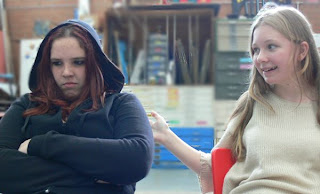Having lived through the past five and a half decades, I've seen a few changes. Technology and information gone mad some of you may say. I say embrace it!
 |
| Warhorse on stage |
At a grass roots level for the actor, whether they be just starting out or established, the tools we now have at our finger tips to promote and train ourselves is virtually limitless.
Scripts and shooting schedules arrive via email, auditions conducted via Skype and I now use an eReader for my scripts when directing.
Online Training
One of the largest and fastest growing facilities in our industry is certainly the information and online training available; whether this be via blogs, YouTube, paid or free courses.
Giving the actor a singing voice
An interesting article and online course I found recently deals with 'Digitial Singing Lessons'. Singing actors are not confined to musical theatre. EVERY actor needs to at least be able to 'carry a tune' and sing in key.
Many plays have a song or two contained within their scenes. To be able to 'carry it off' could be the fine line between getting or not getting the part. Comedy revues also contain many satirical songs as well straight skits. So you really do need to have some kind of singing and voice training.
 |
| digitalvoicelessons.com |
It has been online since 2007 and has many glowing recommendations. The article I found; authored by vocal coach, Janet Lewis, in which this link was contained, I thought was an excellent place to start for any young actor.
I'm only too please to pass on Janet's expertise in how to approach this new teaching medium.
Digital Singing Lessons for Beginners
Beginning singers don’t always know how to get their voices where they want them to be or how they want them to sound. This is because they don’t have the proper training to get the notes that they need to sound right. There are many tools that can help any singer sound better but the best way to improve your voice is by taking digital singing lessons. Digital singing lessons offer you a purer sound that analog does and because they are online, they can be taken anytime. The following are some tips for beginning vocalist to do when the lesson is over.
Don’t Push Too Hard
Remember that you can hurt yourself if you
push too hard. Just like a body builder,
you have to listen to what your body is telling you. A body builder would never work out too long
or too hard because this can damage the muscles or even cause injury. You can also do the same thing to your vocal
chords if you don’t listen to what they are telling you. If you find yourself sounding raspy or if
it’s getting harder to hit notes then you need to take a break and give our
vocal chords a rest. Only go back to
practising when your throat and vocal chords feel better and are not sore.
Practice All the Time
Unless your throat feels sore from the digital singing lessons, you should
sing when and where you can to keep your vocal chords strong. The vocal chords are a muscle just like any
other in the body and they stay strong with regular practice. Practising makes the vocal chords work better
and then the notes you want to hit will be easier to obtain. There are many places that you can practice
if you want to get better. Sing in the
shower, in your car or while you’re cleaning house using all the techniques you
learned during your lessons.
Use the Techniques You Learned
You will be taught many different techniques
to help you become a better vocalist so when you practice you want to make sure
you use these techniques. It can be easy
to fall into old patterns that are not good for beginning vocalists. When you practice you can do scales or sing
to the radio or your music playlist.
Just make sure you use all the breathing
techniques so not only are you working out your vocal chords but you are
also working out your diaphragm. You’ll
learn all about your diaphragm during your digital singing lessons.
Not everyone can become a great
singer. Not only do they have to have a
voice but they also have to have the ear to hear the notes that they want to
sing. But if you have a good tone and
want to be a better singer then you should take digital singing lessons. These are the best way for beginners to learn
everything they need to know to control their breath and vocal chords.
Janet Lewis has been a vocal coach for more
than 10 years and in her free time, she gives tips and advice through articles
and blogs.
Author: Greg Bepper © 2013
Artistic Director
Greg Bepper's Thunderbolt Theatre & Film Productions
thunderbolttheatre.com
Artistic Director
Greg Bepper's Thunderbolt Theatre & Film Productions
thunderbolttheatre.com



















